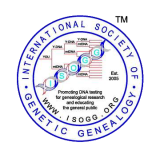Genetic genealogy 2000
From ISOGG Wiki
|
|
2000
Genealogist Alan Savin published his book DNA for Family Historians.[1]
February 2000
Thomas MG, Parfitt T, Weiss DA, Skorecki K, Wilson JF, le Roux M, Bradman N, Goldstein DB Y chromosomes traveling south: the Cohen modal haplotype and the origins of the Lemba - the "Black Jews of Southern Africa". American Journal of Human Genetics 2000 Feb; 66(2): 674-686.
See also: The Lemba - the Black Jews of Southern Africa on Nova Online
March 2000
The Brigham Young University in Provo, Utah, United States, began collecting samples on March 6, 2000. As of September 2002, they had about 32,000 samples, mostly from the United States and the United Kingdom. The samples were later transferred to the Sorenson Molecular Genealogy Foundation. See also the 2003 timeline with link to details.
April 2000
Sykes and Irven Y-chromosome and surname study. The first published study on British surnames and the Y-chromosome (4 markers). Sykes, Bryan and Irven, Catherine. Surnames and the Y Chromosome. American Journal of Human Genetics 2000; 66: 1417-19.
Family Tree DNA sends out its first test kit.[2]
The Mumma DNA project was the first known surname project with a commercial company (Family Tree DNA).[3]
May 2000
The launch of Family Tree DNA, the first commercial testing service in the US to offer genetic genealogy tests to the public. Two tests were initially available: a 12-marker Y chromosome DNA test and an HVR1 (hypervariable region 1) mitochondrial DNA test.[3] The new service was launched to the genealogical community in the US at the National Genealogical Society conference in Providence, Rhode Island, which took place from 31 May to 3 June 2000.
Oxford Ancestors, under the direction of Professor Brian Sykes, was launched the same month. Oxford Ancestors initially offered mitochondrial DNA testing (HVR1).[3] An announcement of the impending launch of a new Y-chromosome test and a MaleMatch service was published in Dick Eastman's newsletter on 12 April 2000.[4]
Gene Tree, Inc., a company that was performing paternity testing, announced its intentions to enter the genetic genealogy market around the same time.[3]
A team from the Institute of Basic Medical Science of the Chinese Academy of Medical Sciences, published a study of three markers in 50 men with family name Wang and compared them to 50 men randomly chosen from the Han Chinese population, showing that there was no difference in the distribution of haplotypes and the family name Wang must have complex origins.[5]
June 2000
Craig Venter and Francis Collins announce sequencing of the entire human genome.
October 2000
Ann P. Turner conducts the first known private mitochondrial DNA study. Turner and her fourth cousin three times removed go back in a straight line of females to their most recent common ancestor Pamela NIMS (b. 1794, Massachusetts).[6] As a result of this, Turner begins the Genealogy DNA discussion list at RootsWeb.
References
- ↑ Alan Savin.Genetic genealogy. Geneanet News, November 2000.
- ↑ Pomery C. DNA and Family History. London: The National Archives, 2004, p105.
- ↑ 3.0 3.1 3.2 3.3 Facts & Genes from Family Tree DNA, Volume 2, Issue 5, June 2, 2003
- ↑ Steadham RL. The saga of how our project evolved. The Stidham Family DNA study website, accessed 9 February 2015.
- ↑ Wu Dongying, Ma Sucan, Liu Ming, Huang Shagzhi, Liu Chunyun, Application of Y-chromosome polymorphisms to studying the kinship of the the males with family name Wang from Han nationality, Acta Anthropologica Sinica, Volume 19, Issue 2, Pages 132-137, May 2000 (in Chinese with English summary)
- ↑ Ann Turner. "Mitochondrial DNA match! Message on Genealogy DNA Rootsweb mailing list, October 21, 2000.
